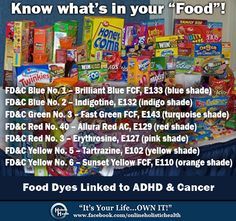What’s Wrong With Artificial Food Dye?

What’s In The Food?
Food Additives and Dyes
As we return from summer vacation and get back to work and/or school, we may be looking into easier foods for snacks, lunches, etc.
Shop prepared: Always take your reading glasses with you because ingredients are printed so small that they can be difficult to read. Read ingredient lists carefully. Ingredients are listed in descending order of the amount used in the product. The first four or five ingredients are very important because they make up the bulk of a product. Look for chemicals and additives.
I have researched how additives, preservatives, and food color dyes can cause many health problems as well as emotional and behavioral problems, especially in children. Children are much more sensitive than adults and their organs are still forming, so it’s even more critical for them to have a high-quality diet.
ADHD and hyperactivity can be misdiagnosed when they actually result from additives in foods. 1, 2
Numerous studies I found on food dyes are quite alarming. For example, “In 2007, a carefully designed, randomized, double-blind, placebo-controlled study published in the journal The Lancet concluded that a variety of common food dyes and the preservative sodium benzoate cause some children to become measurably more hyperactive and distractible.”3
This wasn’t the first time such a link had been established. In 1994, researchers found that 73 percent of children with ADHD responded favorably to an elimination diet that included removing artificial colors. 4
Increasingly since the 1960s, more and more people have come to depend on processed foods containing colored dyes. Many children’s foods, such as juices, soft drinks, candy, gelatins, breakfast cereals, baked and snack foods, salad dressings, frozen desserts, and even foods you wouldn’t normally suspect, such as pickles or fresh produce, are coated in dye to make them look more pleasing.
A 68-page report called Food Dyes: A Rainbow of Risks by the Center for Science in the Public Interest states this:
In addition to considerations of organ damage, cancer, birth defects, and allergic reactions, mixtures of dyes (and Yellow 5 tested alone) cause hyperactivity and other behavioral problems in some children. Because of that concern, the British government advised companies to stop using most food dyes by the end of 2009, and the European Union is requiring a warning notice on most dye-containing foods after July 20, 2010.5
Many major food manufacturers use natural dyes in European foods, while still using the chemical dyes in American foods, because there is still no law in the U.S. banning these food dyes. As the Food Dyes’ report discusses:
Studies of the nine dyes currently approved by the FDA suggest, if not prove, that most of the dyes cause health problems, including cancer, hypersensitivity, or neurotoxicity (including hyperactivity). . . . The health concerns indicate that most dyes fail the FDA’s safety requirement ‘that there is convincing evidence . . . that no harm will result from the intended use of the color additive.’
Fortunately, numerous natural colorings could be used in place of dyes: beet juice, beta-caramel, carotene, carrot juice, chlorophyll, elderberry juice, grape juice/skin, paprika extract, purple corn, purple sweet potato, red cabbage, and turmeric.6
In many ways, we may be able to help ourselves as well as our children by cleaning up our diet. We can teach our children to eat healthier and possibly seeing some beneficial changes before we resort to pharmaceutical medications.
There seems to be a mixed message in giving children drugs for all kinds of ailments, like ADHD for instance. On one hand, adults are telling children, “Do not take drugs.” Then, on the other hand, they are saying, “Take these drugs.” What is the real message we’re giving children?
I feel this subconsciously tells children that (1) “There is something wrong with you,” and (2) “Drugs are okay for solving your problems. Drugs are a quick fix.” Are these the messages we want to give our children?
In the long run, if we can simply clean up our diet and find out if that really is the cause of the problem in the first place, wouldn’t that be better?
Living a healthier lifestyle consuming chemical-free, additive-free organic food, without having to resort to pharmaceutical drugs, could benefit everyone for life.
Sources:
1 “Red Dye 40: Could It Cause Kids to Be Hyper?” http://www.wltx.com/story/news/2014/02/11/1673602
2 Marvin Boris, MD, and Francine S. Mandel, PhD. “Food and Additives are Common Causes of the Attention Deficit Disorder in Children.” Annals of Allergy. October 1994, Volume 73, October 1994.
3 Dr. Joseph Mercola. “First Ever Study Reveals Amounts of Food Dyes in Brand Name Foods.” May 22, 2014. Newsletter. http://articles.mercola.com/sites/articles/archive/2014/05/22/a rtificial-fooddyes.aspx
4 Ibid.
5 Sarah Kobylewski, Ph.D. Candidate. Food Dyes: A Rainbow of
Risks. Center for Science in the Public Interest. Molecular
Toxicology Program. University of California. p. vi.
6 Ibid. p. 15.
By Nancy Addison CHC, AADP
copyright@nancyaddison2017
Leave a comment and join the conversation!
]



